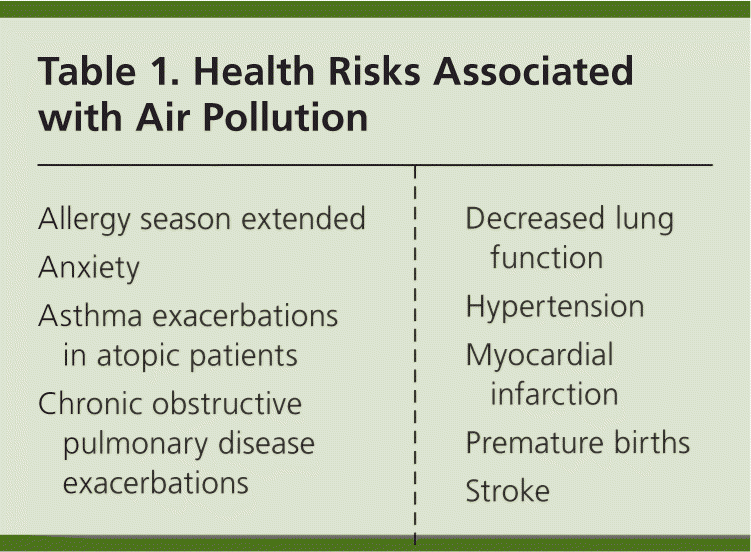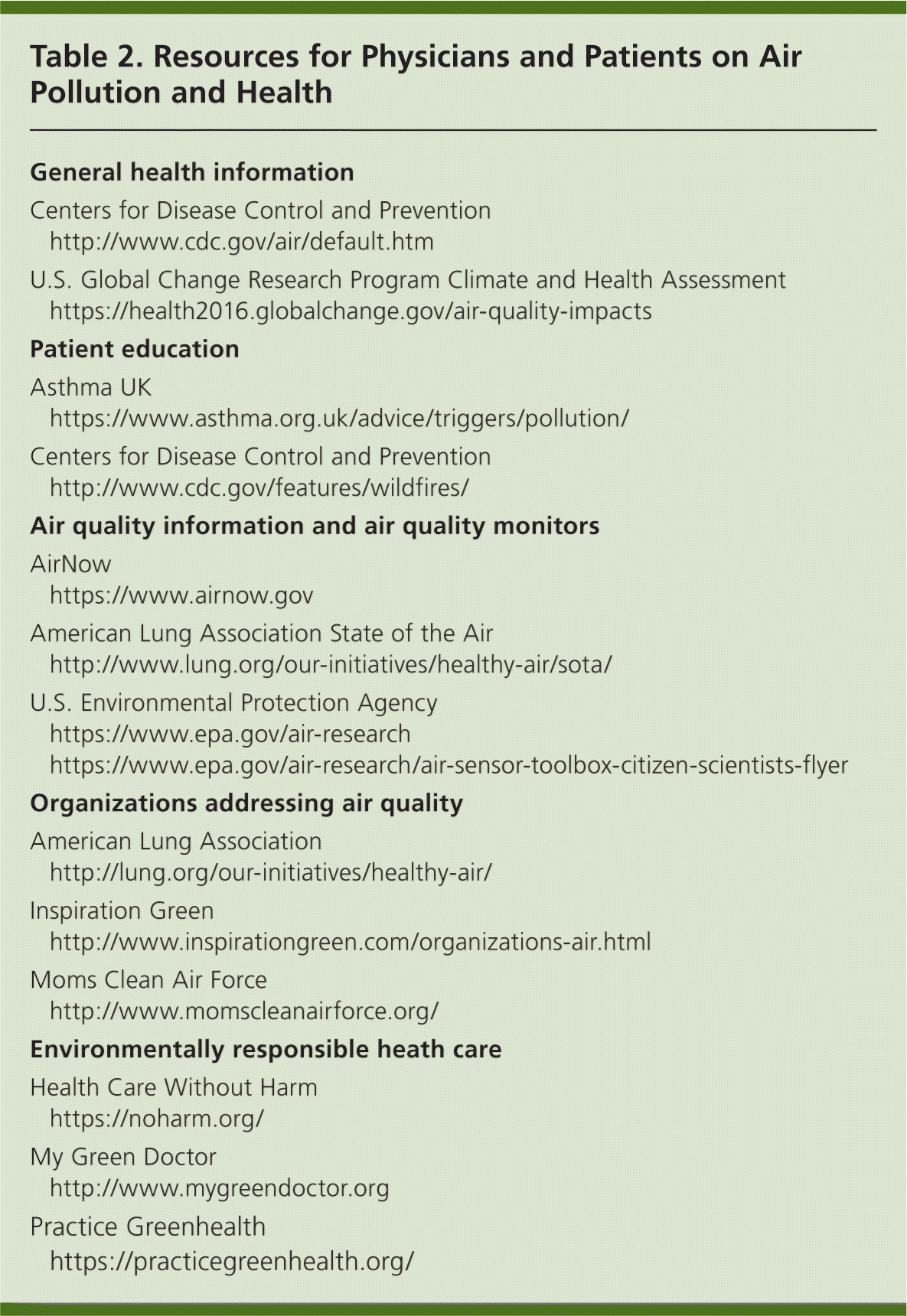
Am Fam Physician. 2017;95(3):146-148
Author disclosure: No relevant financial affiliations.
Air pollution has many deleterious health effects (Table 1). The International Energy Agency recently released a report attributing an annual 6.5 million premature deaths to air pollution worldwide.1 Although the Clean Air Act has done a great deal to improve air quality in the United States since 1970, some of these gains are being eroded in part because of changes in the climate. In fact, many localities have never even been able to meet the Environmental Protection Agency's air quality standards.2 This poor air quality becomes even worse as temperatures continue to rise. Greater warmth and sunlight interact with exhaust to produce more ground-level ozone, a common pollutant and powerful lung irritant.3 Air pollution is associated with a greater risk of chronic obstructive pulmonary disease, independent of smoking history, and increased airway reactivity to allergens in patients with atopic asthma.4–6 Warming temperatures can aggravate the effects of air pollution.7 Increased levels of particulates exacerbate preexisting respiratory conditions and lead to higher rates of hospitalization and death.8 Air pollution is also associated with cardiovascular disease, including stroke and hypertension.9,10 One study also found a link between air pollution and high levels of anxiety.11 In addition, air pollution may contribute to low birth weight, onset of preterm labor, and other negative perinatal outcomes.12,13

| Allergy season extended |
| Anxiety |
| Asthma exacerbations in atopic patients |
| Chronic obstructive pulmonary disease exacerbations |
| Decreased lung function |
| Hypertension |
| Myocardial infarction |
| Premature births |
| Stroke |
Children are more vulnerable to poor air quality than adults. College-aged persons who grew up in areas with poorer air quality had worse lung function compared with their less-exposed peers.14 In longitudinal studies, cohorts of children who lived in areas where air quality improved showed greater improvements in lung capacity on repeat testing than cohorts of children who lived in areas with less improvement.15 Other vulnerable groups include persons who are older, who have preexisting heart and lung disease, and who are poor.16,17 Socioeconomically disadvantaged groups often live in areas with high traffic, areas in proximity to power plants, and in neighborhoods where there are fewer trees to filter pollutants and mitigate high temperatures by providing shade.
Although physicians have no direct control over air quality, they are increasingly called on to help their patients by addressing the environment in which they live. One health system recently took a three-pronged approach to combating local air pollution.18 First, the organization created a working group to study the health impact of air pollution on the community. Second, the group arranged to reduce its own system's contribution to air pollution by installing solar panels, increasing employee reliance on public transportation and clean vehicles, and curtailing medical waste. Third, the group educated their physicians about air quality and developed recommendations to help them counsel patients on limiting outdoor activities in response to different levels of air pollution.
Physicians should advise patients with asthma or lung disease to prepare to step up fast-acting inhaler use and limit outdoor activity when air quality might worsen respiratory conditions.19 The Environmental Protection Agency's Air Quality Index can guide decisions to limit outdoor activities. In general, a value of zero to 50 indicates good air quality, 51 to 150 is considered unhealthy for vulnerable groups, and a value of 151 or greater is unhealthy for everyone.
Patients can monitor air quality themselves by downloading the American Lung Association's free State of the Air app, which provides daily updates about the Air Quality Index for different localities. Real-time air quality index forecasts are also available at https://airnow.gov.
Staying indoors is not always practical. For those who exercise regularly outdoors, the benefits outweigh the risks unless air quality is consistently hazardous.22 Face masks that filter out particles may have protective benefit in some circumstances, such as in areas affected by smoke from wildfires. N95 and N99 face masks and respirators are effective in filtering out particulates 0.1 to 0.3 microns and larger, but are useless against ozone and other gases, such as nitrogen oxide and sulfur dioxide.
According to the International Energy Agency, most of the man-made sources of air pollution are attributable to energy production and use.1 The American College of Physicians recently published a position paper encouraging physicians to recognize the health cobenefits of actions to support the environment.23 Efficient energy consumption, clean transportation, and green practices target the cardiovascular and respiratory effects of air pollution among a wide range of environmental health impacts brought about by climate change. Table 2 provides a list of resources for physicians and patients on air pollution and sustainable health care practices.

editor's note: Caroline Wellbery, MD, PhD, is Associate Deputy Editor for AFP.
The authors thank Kate Price, MPH, and Marybeth Montoro, MPH, for their research assistance.
